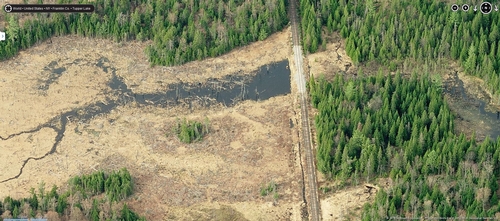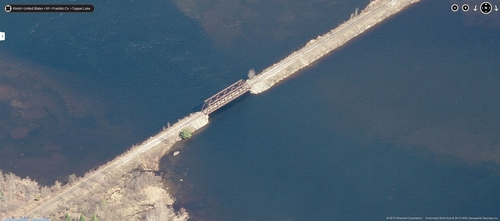Environmental Impacts of the Corridor
Restoration
Before evaluating options for the use of the Corridor it is helpful to consider its setting. As rail lines cannot be steep, the Corridor is routed around the mountains and through the flat lands, which limits the tunnels and bridges required. In the case of the Corridor, the flat lands are usually wetlands, meaning the the line was built by either filling in wetland or crossing unfillable areas with bridges. As wetlands are very valuable environmental resources, providing many habitats and storing and cleaning runoff, this complicates maintenance. These wetlands are one of the biggest challenge to the proposed parralel rail trail combination as they are very well protected under New York State law (UMP 56-57).
Aerial view of a wet area along the Corridor near Tupper Lake, NY. Potential evidence of beaver activity. Image from Bing Maps (Microsoft Corporation and Pictometry Bird's Eye by MDS Geospatial Services Inc.) Image is a link.
It is also impossible to talk about wetlands without also talking about beavers. Beavers love creating wetlands, and their continual building has created bodies of water which threaten the integrity of the Corridor (UMP 56-57). While the UMP suggests that the beavers will be initially treated with less severe measures, it doesn't rule out population reduction and says that trapping will be encouraged along the Corridor (113).
Restoring the Corridor will require filling of washouts or crossing them with bridges for all potential uses of the Corridor. Bridges are not necessarily more environmentally friendly as they require significant construction to create supports that will not wash away. Thus restoring the Corridor will inevitably put some sediment into the surrounding lakes and ponds with the accompanying damage to fish habitats from sedimentation (UMP 104-105). It should be noted though that creating a trail for human use requires a far less strong structure that could be created out of weaker and more environmentally friendly materials, without using fill.
Aerial Image of Bridge on the Corridor Crossing Raquette Pond Near Tupper Lake, NY. Image from Bing Maps (Microsoft Corporation and Pictometry Bird's Eye by MDS Geospatial Services Inc.) Image is a link.
Use
The environmental impacts from use of the Corridor are fundamentally different from many trails in the Adirondacks as the surface of the Corridor has to be regularly maintained and motorized vehicle use will be the prominent use for at least one season during the year. Just looking from a general qualitative point of view, the impacts of either rail or trail are relatively similar. To start with, both require maintenance of the trails involving repairing washouts, leading to sedimentation, and regular clearing of the trail to a lesser extent than restoring the trail, but still significant. Additionally human use of the Corridor creates a variety of other environmental impacts.
Human use from trains, self powered vehicles such as bicycles, and snowmobiles changes the habitat for the animals and plants already living in the area. These devices create noise which reduces the “sense of solitude” (UMP 87) in the areas surrounding the Corridor. This changes the habitat, and may affect the behavior of animals in the surrounding area. Vegetation needs to be kept back from the Corridor so that traffic can be seen coming from both directions. Also fish and small animal populations will come under stress from increased fishing and trapping. Large animals, who would also attempt to use the Corridor for easy travel in the winter, would run the risk of colliding with vehicles on the Corridor. (UMP 105-106)
Image of rail line construction for the Emporium R.R. near Cranberry Lake, NY. Note the environmental change. Image from Adirondack Museum (Image is a link).
The use of the Corridor will result in some increased use of fossil fuels. The increased human traffic will come with an increase in vehicle use to move the people to the Corridor. Corridor maintenance will also require significant use of vehicles and tools to control vegetation and bring in repair materials. In the case of train use, the predicted maximum fuel consumption in the 1996 UMP was 400,000 gallons of diesel fuel a year (123). It’s unclear if this is highway diesel or “farm” diesel, with highway diesel producing significantly less sulfur emissions. These estimates don’t even take into account snowmobile users who will continue to use the Corridor in the winter, generating increased fossil fuel emissions.
Overall there seems to be little difference in environmental impact from either rails or trails as both require construction and will increase human traffic in the area.



